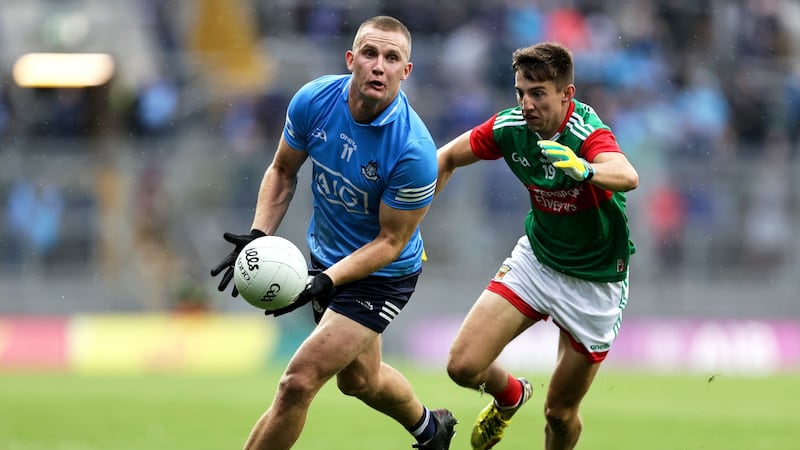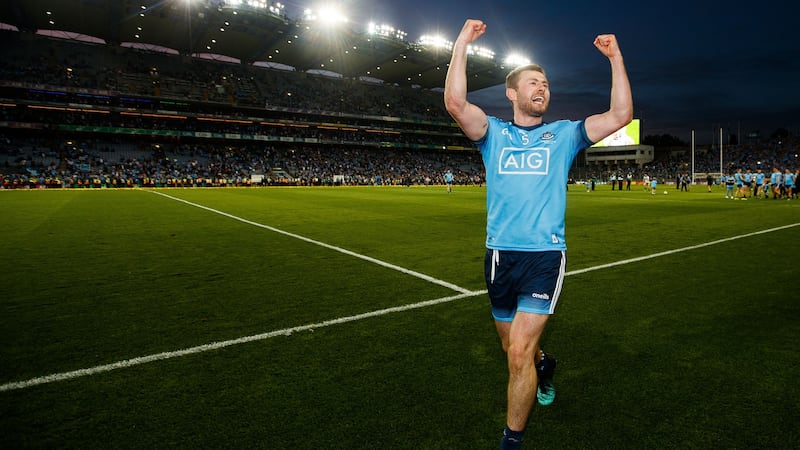Whenever I talk to people about Dublin now, there are two responses. One camp will revert to an old mantra. The Dubs will be hard to beat this year, I think they can do something. Or else you’ll be met with a wince and a belief that their best days are behind them. Opinion is firmly split as to where the Dublin football team stands right now.
It is fascinating. I think we need to look back in order to project what Dublin might do this summer. Remember last year against Mayo: that famous game and the unreal sense afterwards. That day in Croke Park, I felt that Dublin were waiting to be beaten.
For weeks, there was a sense that the day was coming. They were winning out of habit without producing the performances that had, for years, made us stand back. Somehow, even before they relinquished that extraordinary championship record, Dublin had become the hunted. They could feel it themselves. We could feel it. And it made for an extraordinary few weeks which culminated in Mayo’s death blow.
The five in a row dynamic almost created the style. But they got there
And the astonishment of seeing them lose has been exacerbated by the defeats in the national league. Kildare beat them. Kerry beat them. Monaghan enjoyed a memorable day against them. But funny, when I think of Dublin in the league, I immediately recall the day they took Tyrone on in Healy Park. There was an energy and drive and focus about them that day.
Jim McGuinness: Sense of unfairness in disciplinary process a recipe for resentment
Jim McGuinness: New Championship proposals would destroy All-Ireland tradition
Jim McGuinness: Mayo won't offer up the same gifts as Kerry
Jim McGuinness: Gut sense is that Mayo will draw on every past experience and find release
They needed to beat the All-Ireland champions – and did. And they carried that through to Croke Park when they met Donegal a week later. Those games were signs that what we saw was not to be fully believed.
Why is opinion so firmly split about Dublin 2022? After all, their potential is abundantly clear.
Look at the age profile. In the forward line, it is an average age of 27 and the same at midfield. There is nothing wrong in terms of the median age: it is actually perfect in terms of peaking and maturity. So the idea that there is nothing left in the tank does not make sense to me.
Perfect age
I believe 28 years is the perfect age for a Gaelic footballer. And that the peak years are 28-32. Michael Fitzsimons (34) and Jonny Cooper (32) are at the far end of that bracket but there is no sign of decline in either man. And the team excels in key positions. Ciarán Kilkenny is the best centre-half forward in the country. David Clifford and Michael Murphy might rank ahead of Con O’Callaghan at full forward. But then who?

Con’s return changes the dynamic for Dublin. He wins so much dirty ball and carries a frighteningly powerful athletic threat. He is about more than popping the ball over the bar.
Brian Howard, Kilkenny, Niall Scully: where is there a better half-forward line? The talents of Brian Fenton at midfield are clear. So: they are up there. They are in the mix when it comes to talent and age profile.
Then you look at them under the experience category. Well. They are peerless in that regard. They know Croke Park, their de facto home. They have won high-pressure All-Ireland finals in a series of different ways. They know how to close games out. Big days are their bread and butter. Their conditioning is superb. Look at their size. Kerry have put a huge emphasis on this but Dublin are a physically daunting team.
So why, then, have people gone cold on them? Where is the down side?
As a man once said to me: there are three sides to every story: your side of the story, my side of the story. And the truth. Which is probably apt in the context of this debate.
Because there are red flags about Dublin that cannot be ignored.
The first is the vacuum created by the absence of Stephen Cluxton. For all that has been said and written about him, he was imperious. He was almost unplayable for opposition teams. When he exuded that sense of impenetrability, he created then a sense of invincibility which coursed through Dublin at their best.
But he is gone. That is that. So what needs to happen for them now? They need to get at least two per cent ahead of the posse – and by the posse I mean the other goalkeepers and the overall strategies out there. Dublin have to find a way to enable Evan Comerford to at least approach Cluxton’s numbers and stats. The goal threat off the kick-out, the successful kick-outs, all of that: it was the foundation on which the empire was built.
Then you have this intrinsic thing: hunger and desire. Are those qualities there? We simply don’t know right now. Five defeats and relegation to Division Two is a startling fall from grace.

And for me, there is another dynamic and it revolves around the effect that the people who have left have had on the remaining group. I don’t mean their football qualities. I mean the more basic question. Why has Jack McCaffrey left? Why did a guy of that quality walk away at the peak of his career? That has to be asked.
Enough
It’s not for Jack to answer. It’s for the other players to solve because it must be banging about at the back of their minds. Was it because he had won enough? Or that winning All-Irelands didn’t mean enough? Jack wasn’t saying: let’s keep going. Let’s win, eight, nine, 10. He was saying, at the height of his football power: I don’t want to play. Paul Mannion, another superb footballer, has also said: I don’t want to do this anymore.
So it is not what they bring. It is the other side of the question: the abstract impact of their decision to leave. The negative energy created by those departures could easily prey on the minds of the remaining players.
What all of this leaves us with is a contradiction: a team filled with brilliant footballers, laden with titles now in a place that leaves many people unconvinced about them.
Then you come to what happens on the pitch and the style of play which Dublin have adopted. If we trace the evolution of Dublin over the past decade, their football brand went from exuberance, to tactical and cerebral and limitless patience and high percentage scoring. I feel other teams have made that adjustment and are matching Dublin for patience now. They don’t fall for it and don’t allow those guerilla raids as often.
In the early days of the Jim Gavin era, Dublin were all about swashbuckling winning. By the end, it was about winning at all costs. We in Donegal took that win at all costs approach also. But we were coming from a different place. So too did Tyrone last year.
In the latter years of the Gavin era through to Dessie Farrell’s two years in charge, they have had 14 and sometimes 15 players behind the ball regularly. Crucially, this was coupled with an ultra-possession based game. They were looking to draw teams out, to recycle the ball, to create space and then execute high percentage scores – while never exposing themselves defensively.
Result
I think much of that was created by an understandably incredible desire to become the first team to do five All-Irelands in a row. So the five in a row dynamic almost created the style. But they got there. They did achieve that goal. Everything became about the result. And their success has had a profound effect on the game.
The current style with Dublin is where players are very deliberate rather than playing with the old abandon which, let’s be honest, scared the living daylights out of every manager in the country at the time – including myself.
It was incredibly difficult to deal with. So I feel that the gap that has opened up between what Dublin are right now and what they could potentially become is giving all other teams a bit of a hall pass. Be in no doubt: they still have the potential to cause terror.
Last year the general championship fashion was defending the mid-block. We saw it all summer. It meant there was room to kick the ball to the inside line. And room to kick the diagonal ball. But no team was willing to do that. Because teams are wedded to playing through that mid-block. It is what they practice in training and coaches are embedding in, night after night and on the evidence of this year, nobody has come up with anything new.
My sense is that the Dublin management needs to free this group of players up mentally
So this is where Dublin now find themselves. And it is why I feel the start of their season today is so intriguing. Who are Dublin now? What is going to happen?
I feel they need a new approach. Teams are switched on now to their style of play adapted over the past five years. The aura of invincibility has been lost. My sense is that the Dublin management needs to free this group of players up mentally. One way of doing that is new learning. A new page. New drills, a new approach and a new lease of life.
I think they are well placed to innovate and to be creative. In a strange way, all the pressure is off. Because they have the age profile. They have the players. They could build something left-field and surprising. And if they are to get back on top, Dublin need to become the trend setter again and not the hunted.
And if they do succeed in that, their world could turn sunny again very quickly – and for the others, the summer could turn equally dark.















